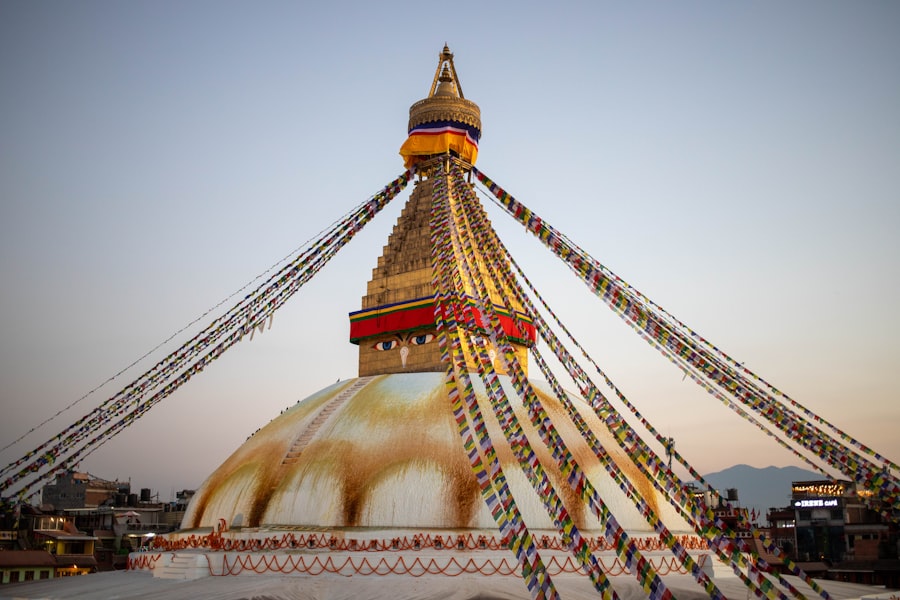The Vedic and early Buddhist traditions represent two of the most significant cultural and spiritual movements in ancient India, each contributing uniquely to the development of religious thought and practice. The Vedic tradition, rooted in the sacred texts known as the Vedas, emerged around 1500 BCE and is characterized by its elaborate rituals, hymns, and philosophical inquiries into the nature of existence. In contrast, early Buddhism, which arose in the 5th century BCE with the teachings of Siddhartha Gautama, known as the Buddha, emphasized personal enlightenment, ethical conduct, and the pursuit of wisdom through meditation and community living.
The structural forms of these two traditions reflect their distinct worldviews and practices, shaping the spiritual landscape of ancient India. Understanding the structural forms of both Vedic and early Buddhist traditions requires an exploration of their respective rituals, cosmologies, and community practices. While Vedic rituals were often grand and public, involving complex ceremonies performed by priests, early Buddhist practices were more introspective and communal, focusing on individual experience and the cultivation of mindfulness.
This article delves into the intricacies of these structural forms, examining how they manifested in rituals, monastic life, and philosophical teachings, as well as their interconnections and influences over time.
Key Takeaways
- Vedic and Early Buddhist structural forms encompass a wide range of rituals, practices, and beliefs that shaped the religious and philosophical landscape of ancient India.
- Vedic structural forms revolve around elaborate rituals, sacrificial practices, and a cosmological worldview that emphasized the interconnectedness of the universe and the divine.
- Early Buddhist structural forms, on the other hand, focused on monasticism, meditation, and the teachings of the Dharma as a path to enlightenment and liberation from suffering.
- A comparison of Vedic and Early Buddhist structural forms reveals both similarities and differences, highlighting the unique contributions of each tradition to the religious and cultural heritage of India.
- The influence of Vedic structural forms on early Buddhist practices is evident in the adaptation and evolution of certain rituals, concepts, and philosophical ideas within the Buddhist tradition over time.
Vedic Structural Forms: Rituals, Sacrifices, and Cosmology
At the heart of Vedic structural forms lies a rich tapestry of rituals and sacrifices that were integral to the spiritual life of ancient Indian society. The Vedas, particularly the Rigveda, Samaveda, Yajurveda, and Atharvaveda, provide detailed accounts of various rituals designed to appease deities, ensure cosmic order (Rta), and promote prosperity. These rituals often involved offerings (yajna) made to fire (Agni), which served as a mediator between humans and the divine.
The performance of these sacrifices was not merely a religious obligation but a means to maintain harmony in the universe and secure blessings for individuals and communities. The cosmological framework within which these rituals operated was deeply intertwined with the Vedic understanding of creation and existence. The concept of Brahman, the ultimate reality or cosmic spirit, was central to Vedic thought.
It was believed that through ritualistic practices, individuals could tap into this cosmic order and align themselves with the divine will. The intricate nature of these rituals often required extensive training for priests (Brahmins), who were responsible for conducting ceremonies with precision to ensure their efficacy. The elaborate nature of Vedic sacrifices also reflected a societal hierarchy where ritual knowledge was a source of power and prestige.
These included ceremonies marking significant life events such as birth, marriage, and death. Each samskara was imbued with spiritual significance, reinforcing social bonds and cultural identity.
The Vedic worldview thus emphasized a structured approach to life that integrated spiritual practice with daily existence, creating a cohesive framework for understanding one’s place in the cosmos.
Early Buddhist Structural Forms: Monasticism, Meditation, and Dharma

In stark contrast to the ritualistic nature of Vedic practices, early Buddhism introduced a structural form centered around monasticism, meditation, and the teachings of Dharma. The Buddha’s rejection of the caste system and elaborate rituals marked a significant departure from Vedic traditions. Instead of relying on priests to mediate between humans and the divine, early Buddhism emphasized direct personal experience as a means to attain enlightenment (nirvana).
This shift was foundational in establishing a new spiritual paradigm that prioritized individual agency over ritualistic adherence. Monastic communities (sanghas) became central to early Buddhist practice. These communities provided a supportive environment for individuals seeking to deepen their understanding of the Buddha’s teachings.
Monks and nuns lived according to strict ethical guidelines (Vinaya), which included celibacy, non-attachment to material possessions, and mindfulness in daily activities. This communal lifestyle fostered an atmosphere conducive to meditation and reflection, allowing practitioners to cultivate insight into the nature of suffering (dukkha) and the path to liberation (the Noble Eightfold Path). Meditation practices within early Buddhism were diverse and aimed at developing concentration (samadhi) and insight (vipassana).
Techniques such as mindfulness of breathing (anapanasati) encouraged practitioners to focus on their breath as a means to anchor their awareness in the present moment. This emphasis on meditation as a tool for personal transformation distinguished early Buddhism from Vedic practices that relied heavily on external rituals. The teachings of Dharma provided a philosophical framework that guided practitioners in ethical conduct and mental cultivation, emphasizing compassion (karuna) and wisdom (prajna) as essential qualities for achieving enlightenment.
Comparison of Vedic and Early Buddhist Structural Forms
When comparing Vedic and early Buddhist structural forms, one can observe fundamental differences in their approaches to spirituality and community life. Vedic practices were predominantly ritualistic, emphasizing external ceremonies performed by priests to invoke divine favor. In contrast, early Buddhism focused on internal transformation through meditation and ethical living.
This divergence reflects broader philosophical differences: while Vedic thought often sought to understand the cosmos through elaborate mythologies and rituals, early Buddhism emphasized personal experience as a pathway to understanding reality. The role of community also varied significantly between the two traditions. In Vedic society, rituals were often communal events that reinforced social hierarchies and collective identity.
The participation of laypeople in these rituals was essential for maintaining cosmic order but was mediated by Brahmins who held exclusive knowledge of the rites. Conversely, early Buddhism fostered egalitarian principles within monastic communities where monks and lay practitioners could engage directly with the teachings without intermediaries. This shift not only democratized spiritual practice but also encouraged a more personal relationship with the teachings of the Buddha.
Moreover, while Vedic cosmology was characterized by a pantheon of deities representing various aspects of nature and existence, early Buddhism introduced a more abstract understanding of reality through concepts such as impermanence (anicca), suffering (dukkha), and non-self (anatta). This philosophical shift had profound implications for how practitioners approached their spiritual journeys. In Vedic thought, achieving harmony with cosmic forces was paramount; in early Buddhism, understanding the nature of suffering and cultivating compassion became central tenets.
Influence of Vedic Structural Forms on Early Buddhist Practices
Despite their differences, early Buddhism did not emerge in isolation; it was influenced by existing Vedic traditions in various ways. The cultural milieu in which the Buddha lived was steeped in Vedic thought, which shaped his initial teachings even as he sought to reformulate them. For instance, certain concepts such as karma (the law of moral causation) can be traced back to Vedic texts.
While early Buddhism reinterpreted karma within its own framework—emphasizing intention behind actions—it retained the fundamental idea that actions have consequences. Additionally, some elements of Vedic ritualism found their way into early Buddhist practices. The use of chanting (sutta recitation) within monastic communities can be seen as an adaptation of Vedic hymns recited during rituals.
These chants served not only as a means of preserving teachings but also as a form of communal practice that fostered unity among practitioners. Furthermore, certain meditative techniques may have been influenced by earlier ascetic practices found within Vedic traditions. The concept of renunciation also has roots in Vedic thought.
Asceticism was practiced by various sects during the time of the Buddha, including those who adhered to extreme forms of self-denial in pursuit of spiritual goals. While early Buddhism advocated for a Middle Way that avoided extremes, it nonetheless acknowledged the value of renunciation as a means to transcend worldly attachments—a theme prevalent in Vedic ascetic practices.
Evolution and Adaptation of Vedic and Early Buddhist Structural Forms over Time

As both Vedic and early Buddhist traditions evolved over centuries, they underwent significant adaptations that reflected changing social contexts and philosophical inquiries. The later development of Hinduism saw a synthesis of various elements from both traditions. The Upanishads emerged as philosophical texts that expanded upon Vedic ideas while incorporating concepts from early Buddhism such as meditation and self-inquiry.
This blending illustrates how spiritual practices can evolve through dialogue between different traditions. In parallel, early Buddhism itself experienced diversification as it spread across Asia. Different schools emerged—such as Theravada in Southeast Asia and Mahayana in East Asia—each interpreting core teachings through unique cultural lenses.
This evolution led to new practices such as devotional worship (bhakti) in Mahayana Buddhism that echoed certain aspects of Vedic devotion while maintaining foundational Buddhist principles. The adaptation of structural forms also extended to monastic life. As Buddhism spread into regions like Tibet and China, monastic communities adapted their practices to local customs while retaining core teachings.
For instance, Tibetan Buddhism incorporated elements from indigenous Bon practices alongside traditional Buddhist teachings, resulting in a rich tapestry of spiritual expression that reflects both continuity and change. In conclusion, the structural forms of Vedic and early Buddhist traditions reveal profound insights into their respective worldviews and practices.
Their evolution illustrates how spiritual traditions can adapt while remaining connected to their historical roots, creating a dynamic interplay between continuity and change in the quest for understanding existence.
For a deeper understanding of the significance of Vedic and Early Buddhist structural forms, one may find the article on “Sartre’s Concept of Existence Preceding Essence: Challenging Traditional Philosophical Ideas and Embracing Individual Freedom” to be an interesting read. This article delves into existentialist philosophy and how it challenges traditional notions of essence and existence, much like how Vedic and Early Buddhist structural forms challenge conventional beliefs and practices. To explore more on this topic, check out the article here.
FAQs
What are Vedic and Early Buddhist Structural Forms?
Vedic and Early Buddhist structural forms refer to the architectural and artistic styles that were prevalent during the Vedic period in ancient India and the early stages of Buddhism.
What are the key characteristics of Vedic structural forms?
Vedic structural forms are characterized by the use of wood and thatch in construction, with a focus on simplicity and functionality. The structures often featured open courtyards and were designed to accommodate religious rituals and ceremonies.
What are the key characteristics of Early Buddhist structural forms?
Early Buddhist structural forms are characterized by the use of stone and brick in construction, with an emphasis on symmetry and symbolism. The structures often included stupas, viharas, and chaityas, and were designed to serve as places of worship and meditation.
How did Vedic and Early Buddhist structural forms influence each other?
Vedic and Early Buddhist structural forms influenced each other through the exchange of architectural and artistic ideas. For example, the use of stone and brick in Early Buddhist structures may have been influenced by the Vedic tradition of using wood and thatch.
What are some notable examples of Vedic and Early Buddhist structural forms?
Notable examples of Vedic structural forms include the Vedic fire altars and the early Vedic houses. Notable examples of Early Buddhist structural forms include the Sanchi Stupa and the Ajanta Caves.
How do Vedic and Early Buddhist structural forms reflect the religious and cultural beliefs of the time?
Vedic and Early Buddhist structural forms reflect the religious and cultural beliefs of the time through their design, symbolism, and use. For example, Vedic structures were designed to facilitate religious rituals, while Early Buddhist structures were designed to serve as places of worship and meditation.























+ There are no comments
Add yours